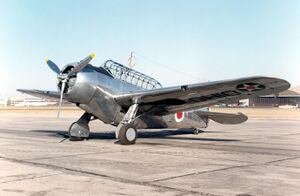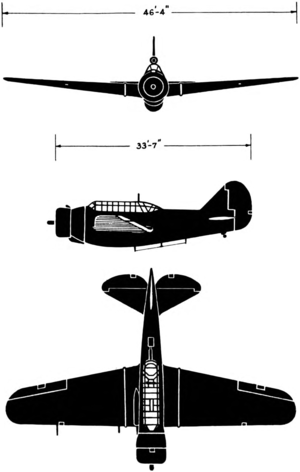Engineering:North American O-47
| O-47 | |
|---|---|

| |
| An O-47B at National Museum of the United States Air Force | |
| Role | Observation |
| Manufacturer | North American Aviation |
| First flight | November 1935 |
| Introduction | 1937 |
| Primary user | United States Army Air Corps |
| Number built | 239[1] |
The North American O-47 is an American observation fixed-wing aircraft monoplane designed in the mid-1930s and used by the United States Army Air Corps during the Second World War. It has a low-wing configuration, retractable landing gear, and a three-blade propeller.
Design and development

The O-47 was developed as a replacement for the Thomas-Morse O-19 and Douglas O-38 observation biplanes. It was larger and heavier than most preceding observation aircraft and its crew of three sat in tandem under the long canopy. Windows in the deep belly overcame the obstacle that the wings presented to downward observation and photography. The design for the XO-47 prototype originated in 1934 with General Aviation Manufacturing, a subsidiary of North American Aviation, as the GA-15.[2] The Air Corps ordered 174 O-47s in 1937 to 1938, 93 of which were assigned to National Guard units. In 1938, the Army ordered 74 O-47Bs with a redesigned engine cowling for better cooling, an uprated engine, and improved radio equipment.[citation needed]
Operational history
Training maneuvers in 1941 demonstrated the shortcomings of the O-47. Single-engined light airplanes like the Piper L-4 and Stinson L-5 proved more capable of operating with ground troops, while fighters and twin engine bombers showed greater ability to perform recon and photo duties. Thus, O-47s during World War II, except for those caught at overseas bases by the Japanese attacks, were relegated to secondary duties such as towing targets, coastal patrol, and anti-submarine patrol.[3]
Variants
- XO-47
- one built, serial number 36-145 in Dundalk, Maryland, 850 hp (634 kW) Wright R-1820-41 engine[1]
- O-47A
- 164 built in Inglewood California, 975 hp (727 kW) Wright R-1820-49 engine
- O-47B
- 74 built, minor improvements and a 1,060 hp (790 kW) Wright R-1820-57 engine installed,[3] plus an extra 50 gallon fuel tank[1]
Operators
- United States Army Air Corps
Surviving aircraft

- 37-279 – O-47A in storage at the Paul E. Garber Preservation, Restoration, and Storage Facility of the National Air and Space Museum in Suitland, Maryland.[4][5]
- 39-098 – O-47B owned by James P. Harker of Blaine, Minnesota. It was previously placed on loan to the Combat Air Museum in Topeka, Kansas by its owner William A. Dempsay, but was sold as of June 2014.[6][7]
- 39-112 – O-47B on static display at the National Museum of the United States Air Force in Dayton, Ohio. It is displayed in the markings of an O-47A belonging to the 112th Observation Squadron of the Ohio National Guard. It was acquired in 1978 from Loren L. Florey Jr., of Eden Prairie, Minnesota and was restored by the 179th Consolidated Aircraft Maintenance Squadron, Ohio Air National Guard, Mansfield, Ohio.[8]
- Composite – O-47A under restoration at the Planes of Fame Air Museum in Chino, California.[9] It is made up of serial numbers 38-284 and 38-295.[5]
Specifications (O-47A)

Data from "United States Military Aircraft Since 1909" [3]
General characteristics
- Crew: three (pilot, copilot-observer, gunner)
- Length: 33 ft 7 in (10.24 m)
- Wingspan: 46 ft 4 in (14.1 m)
- Height: 12 ft 2 in (3.7 m)
- Wing area: 350 sq ft (32.5 m2)
- Empty weight: 5,980 lb (2,712.5 kg)
- Gross weight: 7,636 lb (3,463.6 kg)
- Powerplant: 1 × Wright R-1820-49 radial, 975 hp (727 kW)
Performance
- Maximum speed: 221 mph (355.7 km/h, 192 kn)
- Cruise speed: 200 mph (322 km/h, 170 kn)
- Range: 840 mi (1,352 km, 730 nmi)
- Service ceiling: 23,200 ft (7,071 m)
- Rate of climb: 1,470.8 ft/min (7.47 m/s)
Armament
- 1 × fixed forward-firing .30-cal (7.62 mm) machine gun (200 rounds) in starboard wing
- 1 × flexible .30-cal (7.62 mm) machine gun (600 rounds) in rear cockpit
See also
Aircraft of comparable role, configuration and era
- Curtiss O-52 Owl
- Douglas O-38
- Fieseler Fi 156 Storch
- Henschel Hs 126
- Kokusai Ki-76
- Levente II (ones used in army co-operation and liaison tasks)
- Meridionali Ro.63
- Thomas-Morse O-19
- Westland Lysander
Related lists
References
- Notes
- Citations
- ↑ 1.0 1.1 1.2 "U.S. Army Aircraft 1908-1946" by James C. Fahey, 1946, 64pp.
- ↑ Eden and Moeng 2002, pp. 74–77.
- ↑ 3.0 3.1 3.2 Swanborough and Bowers 1964
- ↑ "North American O-47A". Smithsonian Institution. http://airandspace.si.edu/collection-objects/north-american-o-47a.
- ↑ 5.0 5.1 Goodall, Geoffrey (14 June 2018). "North American". Geoffrey Goodall. http://www.goodall.com.au/warbirds-directory-v6/north-american.pdf.
- ↑ "North American O-47B (FAA Reg. No. N73716)". Combat Air Museum. http://www.combatairmuseum.org/aircraft/namerican047b.html.
- ↑ "FAA REGISTRY [N73716"]. U.S. Department of Transportation. http://registry.faa.gov/aircraftinquiry/NNum_Results.aspx?NNumbertxt=N73716.
- ↑ "North American O-47B". 7 April 2015. http://www.nationalmuseum.af.mil/Visit/Museum-Exhibits/Fact-Sheets/Display/Article/198091/north-american-o-47b.
- ↑ "Restoration Projects". http://planesoffame.org/index.php?page=restoration-projects.
- Bibliography
- Eden, Paul and Soph Moeng. The Complete Encyclopedia of World Aircraft. London: Amber Books Ltd., 2002. ISBN 0-7607-3432-1.
- Fahey, James C. U.S. Army Aircraft 1908-1946. New York: Ships and Aircraft, 1946.
- Swanborough, F.G. and Peter M. Bowers. United States Military Aircraft Since 1909. New York: Putnam New York, 1964. ISBN 0-85177-816-X.
External links
 |
